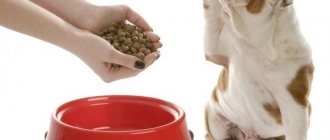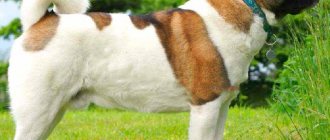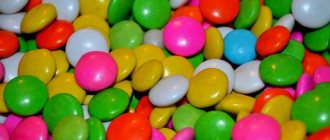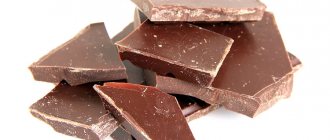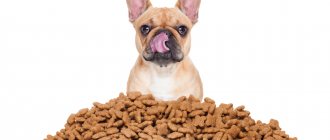Ready-made treats
The range of ready-made treats is not inferior to conventional dry food, and, often, even surpasses them. Many of them are developed taking into account the animal’s life in a large metropolis: unfavorable ecology, “inferior” lifestyle within the city.
When evaluating food, it is better to pay attention to the components that are included in its composition: the ingredients that are listed first are contained in the product in large quantities.
Drops
Drops are suitable as store-bought treats. These are ready-made treats in the form of small teardrop-shaped pieces with different flavors. There is a wide variety of them in the pet store: turkey, beef, chicken, salmon flavors. Ingredients: sugar, milk, butter, cocoa powder, hard cheese. The color varies from light yellow to brown depending on the content of the additional ingredient - cheese or chocolate.
They can be given to dogs of any breed and age. The only limitation is in quantity: the smaller the animal, the fewer drops it receives.
Their number varies - 3-30 per day. The most common manufacturers are GIMBORN, Sanal Choco Drops and Dr. Alder's Drops.
Due to their high sugar, fat and oil content, they are only given during training or as a treat between feedings.
Jerky
A good food for training dogs is jerky. Contains animal meat: ducks, rabbits, birds. It is safe for animals, as it contains nothing but meat. You can feed your dog this treat from early childhood, regardless of breed.
Veterinarians note that such food is both tasty and healthy. It is rich in vitamins and microelements that are necessary for the health and growth of the animal.
Training snacks
All dogs love them without exception. It is suitable for simple training and intensive training. Many chewable snacks, like bones, help clean your pet's teeth.
The snacks are similar in consistency to regular food with a premium composition. In addition to rice, seafood, meat, and fiber, they contain fish oil and L-carnitine, which gives the dog energy and stamina. The downside is the glucose content. Well-known brands – TiTBiT, Beff, Pedigree.
They can only be given to adult dogs. Each package indicates the breed for which the snacks are intended. However, it is better not to include them in the daily diet - due to the glucose in their composition, they can seriously harm your pet.
What treats to use for dog training
When choosing incentive goodies, consider the following aspects:
- The dog must like them. Our pets also have their own food preferences. Buy a few treats to try and let your dog smell them. Use as treats only those foods to which the dog reacts vigorously and joyfully.
- Only healthy food. Avoid harmful additives. If your dog has health problems or is allergic, consult your veterinarian when choosing treats. He will tell you what treats to give your dog during training, so as not to harm its health.
- Feeding should have nothing to do with the regular diet. Everyday nutrition is not of great value for the dog: it receives it regularly and without any effort. For a tasty treat to become a reward, it must differ in taste and smell from regular food. Otherwise, the dog will stop trying to follow commands, because its prize is already available to it.
- You can take the treat with you. You can't hide wet food with gravy or fresh pieces of meat in your pocket. And it’s inconvenient to give such fertilizers by hand. Opt for fertilizers that can be stored in a small container. This will give you the opportunity to reward your dog at any time.
- Small size. Training rewards should be small and easy to swallow. They simulate instant gratification. But chewable and “long-lasting” treats are used to eliminate coprophagia, brush teeth, and instill calm behavior in the home.
Therapeutic and healthy treats for dogs
Supplements with minerals and vitamins are also suitable as an incentive treat. Such delicacies are low-calorie, do not contain harmful substances and are sold as dietary food. They cannot be used on an ongoing basis - they are needed for therapeutic prophylaxis. They can enrich the range of treats offered to the dog. The veterinarian will tell you what vitamin and mineral treat to encourage your puppy during training: each breed has its own requirements. For example, decorative dogs need general strengthening supplements, and large breeds need calcium.
Only an experienced dog handler can quickly teach a dog commands. We invite you to send your puppy to an obedience course at our canine center. We work with dogs of any size, age, breed.
Delicious treats from the table
Due to the wide variety of food in stores, it is difficult to find a product that is safe in composition. Therefore, many dog owners cook for their pets themselves. In addition, many dishes are very easy to prepare.
Dog biscuits
The delicacy can be sweet or salty, consist of fruit or meat. In any form, your pet will like it.
For sweet cookies, just mix flour, chopped rolled oats, eggs and applesauce. You can add raisins, nuts and dried apricots to the resulting dough. It is better to sweeten the treat with honey (not sugar), but in small quantities and if the animal is not allergic to it. Balls are made from the finished dough and placed on a baking sheet. The cookies are dried over low heat for 20-30 minutes. It is better not to overdry it, as due to the hardness of the treat, the animal can damage the gums and teeth.
For meat biscuits, it is important to prepare the minced meat correctly. It consists of finely chopped or twisted meat, beef liver, heart, tripe. It is better not to add spices to the minced meat: the dog has a very delicate sense of smell and can be put off by the pungent smell. The minced meat is mixed with flour and eggs. The resulting mixture is rolled into small balls and baked in the oven. Many owners add garlic to strengthen the dog's immunity. Carrots and cucumbers would be equally healthy additions.
Cheese
Almost all dogs love aromatic cheese, but they do not include it in their regular diet. Due to the high fat content and salt in the composition, it can harm the animal’s liver and kidneys. Small pieces as a reward are perfect and will not cause harm.
Which cheeses are allowed and which are not? It is forbidden:
- sharp, too salty cheeses with any additives;
- smoked cheese;
- product with milk fat substitute and preservatives;
- blue cheeses;
- fragrant aged cheeses.
You can use light low-fat dairy products with a minimum amount of salt and no additives: simple “Russian” or similar varieties.
The main advantages of cheese: it does not crumble, does not stain your hands, is easy to cut into portions, and is liked by almost all dogs without exception. The downside is that your pet may quickly become thirsty, as cheeses contain salt.
To avoid potential allergies, stomach and liver problems, you need to carefully choose a quality product, cut it into small pieces and not overuse rewards.
We prepare our own treats from offal
Due to the fact that there is a large amount of low-quality product on store shelves, many dog owners try to make it themselves.
A simple and common recipe is a treat made from offal. It is done simply: you need to boil the offal or meat of your choice. Then cool, cut into small cubes and place on a tray. If you don’t have enough time for regular drying, you can brown them in the oven. These dried cubes of liver, heart, lung, and chicken stomachs will be a good treat for your pet. These dog training treats are safe for their health.
They contain much more nutrients than meat. By-products contain animal protein, which is the building material of the body. They are rich in microelements and vitamins: iodine, magnesium, potassium, zinc, vitamins A, B, K, E. The amount of healthy Omega-3 and Omega-6 fatty acids is contained in almost the same amount as in fish.
When to stop rewarding?
NEVER
The desired behavior can be reinforced occasionally, but the dog should always have hope. Often this is the reason why the dog suddenly stops following any command. The owner thought that she “already knew her” and relaxed. And a dog is a biological organism that does what is appropriate. If the performance of some actions is not reinforced, it becomes a waste of energy, which is needed for what? Protect. This is a vital need of the body. Therefore, encouragement should never be stopped completely.
Tips for successful training
In order to achieve mutual understanding with the pet as quickly as possible, the owner should know a few tricks when training:
- The main thing is not to abuse it. Yummy food must always be exchanged for a completed command.
- It's good when the dog has a slight feeling of hunger. In this state, she is completely ready for training.
- The treat should be easy to swallow: the pieces should not be larger than 0.5 cm.
- It is better that the food is much tastier than your pet’s everyday food. This motivates the animal.
- The food should not make your dog thirsty. Otherwise, you risk getting a dog that is not ready for training, but an animal looking for a place to get drunk.
- The fertilizer should be easy to store: it’s good when it fits in a belt bag or bag.
How to offer your dog treats
There are also tips on how to give your dog food:
- It is served with an open palm. This method protects your fingers from unpredictable grip by an animal.
- Treats are given from the hand raised up. The dog will quickly react to the prey and will try to get it.
- They work in a static position. Moreover, any encouragement from the owner is also done in a static position.
How to choose a store-bought snack
When purchasing ready-made goodies, you should first study the composition. It should list all the ingredients and the percentage of each component. If the manufacturer does not print this information on the packaging, you should not buy the snack.
The following ingredients are harmful to all dogs:
- BHA, labeled as E-320;
- propyl gallate, E-310;
- propylene glycol, E-1520;
- ethoxyquin, E-324.
The list of ingredients is especially useful to know for owners whose pets suffer from allergies. Some animals may have intolerance to common foods - corn, starch and even chicken.
Additional promotion methods
In addition to food as a reward during training, it is important to use other methods of reinforcement. Stroking and verbal praise are an essential part of training. In this case, the intonation and timbre of your voice is very important, since this is what the animal pays attention to most.
Don't forget about the game. Here the question arises, what kind of entertainment to choose for your dog. However, there are no specific recommendations.
The game can even be similar to a circus performance with juggling balls in the air, the main thing is that your pet can relax and relieve tension during it.
Any encouragement will be a real reward for your dog. It is better not to give preference to any one of them, but to alternate them among themselves. During training, you can treat your dog with food and pet it, and after heavy exercise, it makes sense to relieve stress through play. The main thing is to listen to your pet, and he will definitely reciprocate your feelings.
Discipline
Natalya Kozhina, AiF.ru: Daria, at what age can you start training a puppy and teaching it basic commands?
Daria Kostyuk: Usually a puppy is brought home when he is three months old. At this age, it is useless to master any complex commands; you don’t teach a small child who has just started to roll over to talk. However, some reflexes are still worth developing. For example, going to the toilet not where you want, but where you should. To do this, watch the dog: when it wants to go to the toilet, you need to quickly transfer it to a diaper. Thus, your pet will begin to build an associative series: his desire to go to the toilet with a specific place. Discipline on various commands - voice or gesture - can be started at six months. But again, do not forget that this is still a small puppy, so it is better to teach it in a game so that it is interesting for him.
Question and answer Why are people divided into dog lovers and cat lovers?
— I have always been interested in the question of how a dog understands the meaning of words, for example “no”?
- Of course, a dog does not understand the meaning of words like a person. It simply remembers what to do when you say a specific phrase. Everyone gives the “no” command differently: fu, stop, etc. I sometimes laugh about the fact that you can say anything, even “a bucket.” The main thing is that the meaning you put into the word is exactly what you need.
It is also important not to inflect words. You cannot say sit today, sit down tomorrow, etc. For a dog these will be two different words. She simply won't understand what you want from her.
Don't be afraid, she won't bite! 7 phrases from dog breeders that you should not trust
More details
— Is it possible to use physical force during the training process, for example, lightly slapping the dog on the butt?
— I don’t hit my pets, but in case of emergency I can pick them up and pull them a little, you know, like a person’s shoulders.
Another option is to use a newspaper or a broom for educational purposes. Firstly, this way the dog will not be afraid of hands; he will only expect affection from hands. Secondly, he won’t like this rustling sound, but he won’t experience any really severe pain either.
By the way, not every dog will perceive your spanking on the butt as punishment. I have a commander who considers such spankings to be praise, just like a horse being slapped on the neck.
In general, many animals respond well to voices. If I start to get angry, the dogs immediately understand that something is wrong. And there is no need for any extra movements. A commanding voice is a very good stop signal.
Question answer
Why does a dog chase its tail?
— Daria, of course, many things are taught from birth, but if you get an adult dog, for example, from a shelter, is it possible to teach it some commands? Or is this unrealistic?
- Realistically, but, of course, it will be more difficult for you, since she was raised not by you, but by other people or the street. This situation usually requires more time and attention. Understand what your dog likes and what he doesn't. If she is terribly afraid of something, under no circumstances should she be punished with this. Figure out what is already inherent in the dog, what fears, knowledge, habits and act based on this.
— Is it true that there are breeds that are less amenable to training?
- Yes, that’s true, I was convinced of this from my own experience. We have Huskies, Pomeranians, Chow Chows and Komondors. Laikas and Spitzes are ideal for training; perhaps these are the most circus dogs along with poodles. But the Chow Chow is very difficult to train. It seems like they have a short memory.
Spitz dogs are ideal for training. Photo: www.globallookpress.com
— Is this how nature intended it?
- Certainly. Genetics is a very important factor. Let’s say the Chow Chow is an artificially bred breed; it was created not to serve a person, to be his friend, to guard his home, but to eat it. Even their health begins to suffer greatly after a certain age, and all because their ancestors did not live to an old age, they were simply eaten. It is clear that in terms of training, no one has trained this breed. She was bred like cattle.
For example, Yorkies are decorative dogs, they are accustomed to pads and bags. You obviously can’t teach them to jump somersaults or pull a toy sled, their self-preservation instinct will simply kick in. They won't follow your complex commands.
Article on the topic
Homecoming. What to consider when moving a pet from the countryside to the city
— So, if I’m not ready to work long and hard on a dog, then it’s better not to buy a chow chow, otherwise I’ll end up with a completely uncontrollable dog?
“In that case, no breed will suit you.” After all, you are dealing with an animal that has teeth. If you don’t deal with it, at the very least it will result in some torn things and chewed shoes. It is especially dangerous in this case to take a large dog. If he does not feel your strength, system and discipline, then sooner or later he will show his character. Although, of course, some small breeds may be suitable, since they cannot cause global harm, but again, any dog needs to be taken care of.
Chow chows are difficult to train. Photo: AiF-Samara/ Ksenia Zheleznova






